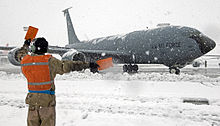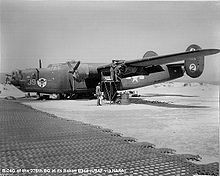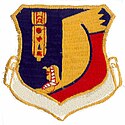| 376th Air Expeditionary Wing | |
|---|---|
 376th Air Expeditionary Wing emblem | |
| Active | 2001–Present |
| Country | United States |
| Branch | United States Air Force |
| Type | Air Refueling |
| Role | Combat Support |
| Part of | Air Combat Command/US Central Command |
| Garrison/HQ | Transit Center at Manas, Kyrgyzstan |
| Motto(s) | LIBERANDOS |
| Engagements |
|
| Commanders | |
| Notable commanders | Richard W. Fellows |

The 376th Air Expeditionary Wing (376 AEW) is a provisional United States Air Force Air Combat Command unit. It is currently stationed at the Transit Center at Manas International Airport, Kyrgyz Republic
A World War II predecessor unit, the 376th Bombardment Group (Heavy) was the first B-24 Liberator group to be based on European Continent. It engaged in combat with the Ninth, Twelfth and Fifteenth Air Forces in the Egypt-Libya and Italian Campaigns. the 376th was awarded Distinguished Unit Citations: for operations over North Africa and Sicily, Nov 1942-17 Aug 1943; Ploesti, Romania, 1 Aug 1943 and Bratislava, Czechoslovakia, 16 Jun 1944. The B-24 "Lady Be Good" was from the 514th Bomb Squadron.
Mission
The 376th Expeditionary Wing is responsible for providing air combat power projection throughout the CENTCOM Area of Responsibility, including tactical airlift and air refueling, principally in support of OPERATION ENDURING FREEDOM. C-17 and KC-135 aircraft are involved in this effort. Additionally, the wing serves as a hub for strategic airlift operations and as an intermediate staging base for transiting personnel and equipment in support of operations in Afghanistan. The wing hosts transient forces from coalition nations, as well as transient forces of the United States Army, Marine Corps and Navy.[1]
Units
- 376th Expeditionary Operations Group
- The 376 EOG is the lead KC-135 aerial refueling unit for Afghanistan operations. Other USAF aircraft supporting the mission include KC-135s and C-17s.
- 376th Expeditionary Maintenance Group
- 376th Medical Maintenance Group
- 376th Expeditionary Mission Support Group
History
The 376th Air Expeditionary Wing is authorized to display the honors earned by the 376 Expeditionary Operations Group before 1 Jun 1951, however the lineage and history of the units are separate prior to that date.
Lineage
- 376th Expeditionary Operations Group
- Constituted as 376th Bombardment Group (Heavy) on October 19, 1942
- Activated on October 31, 1942
- Redesignated: 376th Bombardment Group (Very Heavy) in May 1945
- Inactivated on November 10, 1945.
- Redesignated: 376th Reconnaissance Group
- Activated on May 23, 1947.
- Inactivated on September 20, 1948
- Redesignated: 376th Bombardment Group and activated on 1 Jun 1951
- Inactivated on 16 Jun 1952 (never made operational)
- Redesignated 376th Expeditionary Operations Group, and converted to provisional status, on 4 Dec 2001
- 376th Air Expeditionary Wing
- Established as 376th Bombardment Wing (Medium) on May 25, 1951
- Activated on June 1, 1951.
- Discontinued, and inactivated on March 15, 1965.
- Redesignated: 376th Strategic Wing on 23 Jan 1970
- Scheduled to replace the 4252nd Strategic Wing on 1 Apr 1970
- Activated on 1 Apr 1970 assuming the resources (Manpower, Aircraft, Equipment, Weapons, & Facilities) of the 4252nd Strategic Wing
- Inactivated October 30, 1991
- Redesignated 376 Air Expeditionary Wing, and converted to provisional status, on 4 Dec 2001
Assignments
|
|
Components
- 376th Expeditionary Operations Group
- 512th Bombardment (also Reconnaissance) Squadron, 31 Oct 1942-10 Nov 1945; 23 May 1947-20 Sept 1948; 1 Jun 1951-16 Jun 1952
- 513th Bombardment (also Reconnaissance) Squadron, 31 Oct 1942-10 Nov 1945; 23 May 1947-20 Sept 1948; 1 Jun 1951-16 Jun 1952
- 514th Bombardment (also Reconnaissance) Squadron, 31 Oct 1942-10 Nov 1945; 23 May 1947-20 Sept 1948; 1 Jun 1951-16 Jun 1952
- 515th Bombardment Squadron, 31 Oct 1942-10 Nov 1945
- 376th Air Expeditionary Wing
Groups
- 376 Bombardment Group: 1 Jun 195 1-16 Jun 1952 (not operational)
Squadrons
- 65 Strategic: 1 Jul 1990-2 Oct 1991
- 82d Strategic Reconnaissance Squadron: 1 Apr 1970-30 Sept 1976
- 91st Air Refueling Squadron: 1 Dec 1957-15 Jun 1964
- 376 Air Refueling: 18 Aug 1953-1 Dec 1957
- 512: attached 1 Jun 1951-15 Jun 1952, assigned 16 Jun 1952-15 Mar 1965
- 513: attached 1 Jun 1951-15 Jun 1952, assigned 16 Jun 1952-15 Mar 1965
- 514: attached 1 Jun 1951-15 Jun 1952, assigned 16 Jun 1952-15 Mar 1965
- 515 Bombardment: 1 Dec 1958-1 Jan 1962
- 909th Air Refueling Squadron: 1 Jul 197 1-1 Oct 1991 (detached 5 Nov 1990-15 Mar 1991)
- 4102d Air Refueling, Provisional: attached 6 Jun-8 Nov 1972; attached 18 Dec 1972-22 Jan 1973
- 4180 Bombardment: 1 Apr-1 Jul 1970 (not operational)
- 4220 Air Refueling: 1 Apr 1970-31 Jan 1971
- 4363 Support (later, 4363 Post Attack Command and Control): attached 20 Jul 1962-15 Feb 1965
Stations
|
|
Aircraft
|
|
Operational history
World War II



The 376th Bombardment Group has its origins in the British mandate of Palestine, as a result of the buildup of American air power in the Middle East in January 1942.
Following the Attack on Pearl Harbor, President Franklin D. Roosevelt ordered the Army Air Forces to mount retaliatory raids on the Japanese home islands. A task force, commanded by Colonel Harry E. Halverson and composed of 231 officers and enlisted men and 23 B-24D Liberator bombers, was assembled at Fort Myers Army Airfield, Florida. The unit was given the code name "HALPRO" for Halverson Project. This organization, destined to be the parent unit of the 376th Bombardment Group, departed the United States on 20 May 1942 over the southern Air Transport Command route though the Caribbean and Natal Brazil and across Central Africa and arrived at RAF Lyddia in Palestine. However, before the group could depart for India and begin attacks on Japanese targets from a base located in China, the unit learned that its' proposed base in China had been captured by Japanese forces.
To make matters worse, the German Afrika Korps under General Erwin Rommel was poised to attack Allied forces in Egypt. HALPRO was quickly diverted from its' original mission to a new one: interdictory raids from airfields in Egypt against shipping and North African ports supporting Axis operations as part of United States Middle East Air Forces (USMEAF) on 20 June 1942, a quickly assembled organization based in Cairo. The Halverson Project was dissolved and the organization was renamed the 1st Provisional Bombardment Group.
With the formation of Ninth Air Force on 12 Nov 1942, all First Provisional personnel and B-24s were transferred to the newly activated 376th Bombardment Group. The order became effective on 31 October 1942 and as a subsequent gesture of unit identity, members of the 376th adopted the nickname "Liberandos". Rapid build-up of personnel and aircraft in early 1943 resulted in the formation of a fully formed group composed of the 512th, 513th, 514th and 515th Squadrons.
Initially, the 376th was formed with the 23 B-24s which had flown from Florida, along with along with a detachment of B-17Ds from the 7th Bombardment Group (Heavy) and other personnel. Some of the B-17s were Pearl Harbor attack and Philippines campaign survivors, which had been assigned to the China Burma India Theater. After the Japanese capture of Burma the Burma Road was cut so the detachment could not be logistically supported in China. By the end of 1942, all of the squadrons were equipped with B-24 Liberators as the older model B-17s were reassigned to non-combat roles.
Operating from bases in Palestine, Egypt, Libya and Tunisia, the 376th attacked shipping in the Mediterranean and harbor installations in Libya, Tunisia, Sicily, and Italy to cut enemy supply lines to North Africa. Struck airdromes, marshalling yards, and other objectives in Sicily and Italy after the fall of Tunisia in May 1943. Received a Distinguished Unit Citation for action against the enemy in the Middle East, North Africa, and Sicily, November 1942 – August 1943. Participated in the famed low-level assault on oil refineries at Ploesti and received another DUC: nearing Ploesti on August 1, 1943 and realizing that it was off course, the group attempted to reach its assigned objective from another direction; by this time, however, enemy defenses were thoroughly alerted and intense opposition forced the 376th to divert to targets of opportunity in the general target area.
The B-24 "Lady Be Good" was from the 514th Bomb Squadron.
With the transfer of Ninth Air Force to England in 1943, the 322d was reassigned to Fifteenth Air Force and moved to Manduria, Italy under the 47th Bomb Wing. From Italian bases, the unit engaged primarily in long-range missions to targets in Italy, France, Germany, Czechoslovakia, Austria, Hungary, and the Balkans to bomb factories, marshalling yards, oil refineries, oil storage facilities, airdromes, bridges, harbors, and other objectives.
Received a Distinguished Unit Citation for attacking the oil industry at Bratislava on June 16, 1944. Also flew support and interdictory missions, assisting Allied forces at Anzio and Cassino during February–March 1944, supporting the Invasion of Southern France in August 1944, aiding the Russian sweep into the Balkans during the fall of 1944, and assisting Allied troops in northern Italy during April 1945.
Flying from North Africa and Italy, the Group flew 451 missions, was awarded three Distinguished Unit Citations and earned 15 campaign awards. The Liberandos destroyed 220 enemy aircraft in aerial combat and suffered casualties totalling 1479 officers and enlisted personnel and 169 aircraft.
With the end of the war in Europe, the 322d Bomb Group was reassigned to Harvard AAFld, Nebraska, May 8, 1945 and redesignated 322d Bombardment Group (Very Heavy) and began B-29 Superfortress transition training in preparation for a move to the Pacific Theater of Operations. However with the end of the war in August, the training ended and the unit was inactivated at Grand Island AAF, Nebraska on November 10, 1945.
Cold War

The unit was redesignated the 376th Reconnaissance Wing and activated at Gravelly Point, Virginia on May 23, 1947. The wartime 512th and 513th squadrons were assigned to the wing and equipped with B/WB-29s. The unit operated as a weather reconnaissance group until its inactivation on September 20, 1948.
The 376th Bombardment Wing, Medium, was established on May 25, 1951, and activated at Forbes AFB, Kansas on June 1, 1951. The wing was initially equipped with B-29 Superfortresses and trained in strategic bombardment operations. Beginning in September 1953, the wing began engaging in Electronic countermeasures operations, which became the wing's primary mission. Included EB-47 Stratojet post attack command and control operations, December 1962 – February 1965. The wing gained the 376th AREFS, equipped with KC-97 Stratotankers, on August 18, 1953. The unit was deactivated at Lockbourne AFB, Ohio, on 15 March 1965 as part of the phaseout of the B-47 from the USAF inventory.
376th Strategic Wing
The origins of the 376th Strategic Wing come from the establishment of the 4252d Strategic Wing at Kadena Air Base, Okinawa on 12 January 1965. The 4252d SW was a provisional SAC MAJCOM unit established by SAC with the responsibility of supporting B-52D Stratofortresses and KC-135 Stratotankers from SAC CONUS-based units engaged in combat operations over Southeast Asia from Kadena on a daily basis during the Vietnam War. The 4252d equipment consisted of about 70 KC-135 Tankers that refueled tactical fighters over the South China Sea and Gulf of Tonkin that were carrying out attacks on North Vietnam. In addition the aircraft would evacuate personnel to the Philippines, Guam etc for Typhoons and continued to fly their scheduled refueling missions. The B-52s would conduct Arc Light strategic bombardment missions over Indochina, refueling from the tankers on their return trip to Kadena.
In 1970, in order to retain the lineage of its provisional wing at Kadena, Headquarters SAC received authority from Headquarters USAF to discontinue its MAJCOM wing and activate a regular AFCON wing which was inactive at the time which could carry a lineage and history of the mission at Kadena. On 1 April 1970, the 4258th SW was redesignated as the 376th Strategic Wing.
The rotational B-52 elements were shifted to the 307th Strategic Wing, assigned to U-Tapao Royal Thai Navy Airfield, Thailand soon afterward. Using aircraft and crews deployed from CONUS-based SAC wings, the 376th SW controlled the 909th Air Refueling Squadron (KC-135A/Q/R) and supported rotational reconnaissance aircraft (TR-1, SR-71). It conducted airborne radio relay operations, April–November 1970; February–June 1971 and March 1972 – August 1973. The Wing was inactivated at Kadena on 30 October 1991 with the drawdown of strategic forces after the end of the Cold War. Its mission was absorbed by the host 18th Wing.
Global War On Terrorism
Manas air base operations began December 16, 2001 and included the 86th Contingency Response Group from Ramstein Air Base, Germany as well as contractors and French engineers. Since then it has hosted forces from Australia, Denmark, France, Italy, New Zealand, Norway, South Korea, Spain and the Netherlands. Coalition aircraft previously based here have included tankers (KC-135s), tactical airlift (C-130s), fighters (F-18, F-16, Mirage 2000) and helicopters (Super Puma).
References
![]() This article incorporates public domain material from the Air Force Historical Research Agency
This article incorporates public domain material from the Air Force Historical Research Agency
Notes
Bibliography
- Byers, Richard G. Attack: Death in the Skies Over the Middle East. Winona, Minnesota: Apollo Books, 1984.
- McClendon, Dennis E. The Lady Be Good: Mystery Bomber of World War II. Fallbrook, California: Aero Publishers, Inc., 1962 (2nd edition 1982).
- Rogers, B. United States Air Force Unit Designations Since 1978. 2006. ISBN 1-85780-197-0.
- Ravenstein, Charles A. Air Force Combat Wings: Lineage and Honors Histories, 1947–1977 Washington, DC: USGPO, 1984.
- Uncredited. 200th Mission, Liberator-Athens-Tatos A/D Dec. 14, 1943. APO 681, Italy: 376th Bomb Grp.,1943.
- Uncredited. A Short History of the 376th Bombardment Group, May 20, 1942 – February 22, 1945. N.p. 1945.
- "US Air Force Air Power Directory" World Airpower Journal. London: Aerospace Publishing, 1992. ISBN 1-880588-01-3.
- Walker, James W. The Liberandos: A World War II History of the 376th Bomb Group (H) and Its Founding Units. Waco, Texas: 376th Heavy Bombardment Group Association, 1994.
- Johnson, David C. (1988), U.S. Army Air Forces Continental Airfields (ETO), D-Day to V-E Day; Research Division, USAF Historical Research Center, Maxwell AFB, Alabama.
External links
| Air Forces | |||||||||
|---|---|---|---|---|---|---|---|---|---|
| Centers | |||||||||
| Bases | |||||||||
| Wings |
| ||||||||
| Leadership |  | ||||||||||
|---|---|---|---|---|---|---|---|---|---|---|---|
| Structure |
| ||||||||||
| Personnel and training | |||||||||||
| Uniforms and equipment | |||||||||||
| History and traditions |
| ||||||||||




